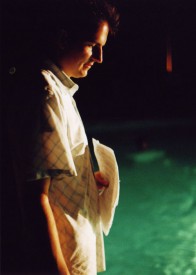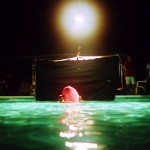A few posts back I wrote about See Saw, the thriller directed by Tom Muschamp which I DPed in the summer of 2007. Today I’m going to share some of the tribulations experienced in the making of this sequence:
The sequence was filmed in the Hamptons, a popular holiday destination at the east end of Long Island, near New York City. The boat was filmed in a harbour, with the camera and an HMI lamp on the dock. I wish we could have put either the camera or the HMI in another boat, because it’s never a good idea to have your camera and your only light source close together; you end up with flat lighting that looks like flash from a stills camera. Unfortunately we didn’t have much choice. Putting the HMI on a boat was too dangerous, and putting the camera on a boat would have rendered the footage too shaky for successful compositing with the other element of the sequence: Katherine.

Katherine, played by producer Aimee Denaro, was filmed in an outdoor swimming pool – again, of course, at night. We had been able to get hold of a single black drape, which we rigged half in and half out of the water, to hide the stand for the backlight and to cover the blue-painted pool interior. We originally planned to frame all our shots tightly enough that this drape would fill the entire background, but we ended up shooting off it quite a lot. Fortunately the surroundings were dark enough that we got away with it.
Aside from the backlight there was one other lamp – a key light coming in from the side. Both were 800W tungsten pars if memory serves. As I often do on night sequences, I white-balanced on a red-gelled lamp, fooling the camera into turning everything blue for that classic James Cameron/Michael Mann look.

After shooting all the set-ups from the poolside, it was time to dive in – quite literally – and shoot the underwater material. That’s when the fun began.
We had spent the last couple of weeks trying to find an underwater housing we could hire, but nowhere had one that would fit our camera (a JVC GY-HD110). In the end we had to settle for a splash bag designed for ENG (i.e. proper broadcast) cameras. A splash bag is simply a rubber bag with a waterproof zip and a porthole of optical glass at one end. They’re not designed to be used at any depth, but will keep the water out down to a metre or two. So far, so good – this restriction fitted in with Tom’s shot requirements just fine.
But because our camera was too small, we could not screw the filter thread into the porthole inside the bag. This meant there was no way of keeping the camera in a fixed position within the bag. This was, not to beat about the bush, annoying. Oh, and did I mention that the battery adapter on the camera had a loose connection which caused the camera to shut itself off sometimes?

Anyone who knows me knows that I am very quiet. I doubt most of the cast and crew were accustomed to hearing me say much of anything. They were certainly all pretty shocked when, within a few minutes of starting to work with the splash bag, I was cursing and swearing like a trooper. The difficulties of trying to swim, keep the bag underwater (it had plenty of empty space in it so it wanted to float), keep the camera lens lined up with the porthole, prevent the focus ring from rubbing against the inside of the bag and throwing the image out of focus, all at the same time, almost drove me insane. Add to that the battery coming loose from time to time and you can see how I might have been a tad frustrated.
But after a while I learnt to contort my body and the bag into a stable configuration and we got some great shots. By the time we wrapped, thanks to the pool’s automatic overnight chlorination system, we all had red, stinging eyes and Aimee’s top had been completely bleached.
The next time I shot underwater – which I may blog about in the future – rather than trying to hire a housing to fit our camera, we hired a housing that came with its own camera. In hindsight I wish we’d done this on See Saw. If you’re going to try it yourself, I’d recommend getting hold of some diving weights because you’re always fighting the natural buoyancy of the housing. Remember that tiled walls and painted lane divisions are dead giveaways that you shot in a swimming pool; don’t rely on the distorting effect of water to hide these – it doesn’t work that way. Bring drapes or tarpaulins to fill your background.
Okay, that’s all for now folks, but if you enjoy reading this blog then please consider contributing a little cash towards my new short film Stop/Eject.
